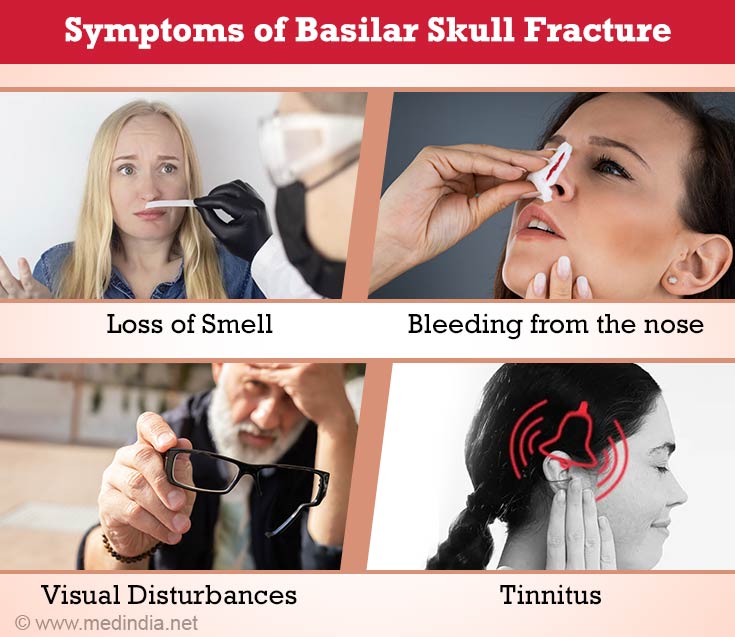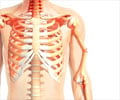- Skull Fracture - (https://medlineplus.gov/ency/article/000060.htm)
- Skull Fractures - (https://www.healthline.com/health/skull-fracture#Overview1)
- Skull Fracture - (https://emedicine.medscape.com/article/248108-overview)
- Pediatric Skull Fractures - (https://www.ncbi.nlm.nih.gov/books/NBK482218/)
- Basilar Skull Fractures - (https://www.ncbi.nlm.nih.gov/books/NBK470175/)
- Basal skull fracture and the halo sign - (https://www.ncbi.nlm.nih.gov/pmc/articles/PMC3602259/)
- Head injury - first aid - (https://medlineplus.gov/ency/article/000028.htm)
- Growing Skull Fractures; Pathogenesis and Surgical Outcome - (https://www.ncbi.nlm.nih.gov/pmc/articles/PMC8477810/)
- Stress Fractures - (https://www.ncbi.nlm.nih.gov/books/NBK554538/)
- Occipital condyle fractures: report of five cases and literature review - (https://www.ncbi.nlm.nih.gov/pmc/articles/PMC3454667/)
- Frontal Bone Fractures and Frontal Sinus Injuries: Treatment Paradigms - (https://www.ncbi.nlm.nih.gov/pmc/articles/PMC6933972/)
- Orbital Fractures - (https://www.ncbi.nlm.nih.gov/pmc/articles/PMC8604618/)
- Bone Fracture - (https://www.betterhealth.vic.gov.au/health/conditionsandtreatments/bone-fractures)
- Intracerebral Hemorrhage - (https://www.ncbi.nlm.nih.gov/books/NBK553103/)
- Traumatic Cerebrospinal Fluid Leak: Diagnosis and Management - (https://www.ncbi.nlm.nih.gov/pmc/articles/PMC5702760/)
- Cranioplasty: Review of materials and techniques - (https://www.ncbi.nlm.nih.gov/pmc/articles/PMC3159354/)
- Postconcussive Syndrome - (https://www.ncbi.nlm.nih.gov/books/NBK534786/)
About
Skull Fracture is an injury that causes a break in the outer layer of the skull bones.
A skull fracture is a type of head injury in which the skull bone is broken or cracked. The most common cause of skull fracture is trauma with a large amount of force, enough to overwhelm the strong bones of our cranium. Hence, any severe trauma, like falling from a height, a road traffic incident, gunshot wounds, or being hit with a hard object, can cause a skull fracture. In some cases, skull fractures can happen with seemingly little force; these are called pathological fractures. In such cases, it is important to rule out some systemic causes for weakness of the bones, which include osteoporosis, multiple myeloma, and cancer that has spread to the bones(1✔ ✔Trusted Source
Skull Fracture
Go to source). The ICD-10-CM Code for Fracture of skull is S02.91XA.
Head trauma causes skull fractures in children and is the leading cause of morbidity and mortality in children. It is a common occurrence in the Paediatric Emergency Department (PED) and primary care. Children are more vulnerable than adults to head trauma and skull fractures(2✔ ✔Trusted Source
Pediatric Skull Fractures
Go to source).
Types of Skull Fracture
There are many types of skull fractures. The two most basic types are simple (or closed) fractures and compound (or open) fractures. The various types of fractures that belong to one or the other of the above two broad categories are:
Basal skull fracture
Basilar or basal skull fractures, which are frequently caused by significant blunt force trauma, involve at least one of the bones that make up the base of the skull. Basilar skull fractures most usually involve the temporal bones, but they can also involve the frontal bone's occipital, sphenoid, ethmoid, and orbital plates(3✔ ✔Trusted Source
Basilar Skull Fractures
Go to source).
Open skull fracture
An open, or penetrating, head injury occurs when an object breaks the skull and enters the brain. This is more likely to occur when moving at high speeds, such as when crashing through a windscreen in a car collision. It can also occur as a result of a gunshot to the head(4✔ ✔Trusted Source
Head injury - first aid
Go to source).
Growing skull fracture
Expanding skull fractures are a rare consequence of childhood head injuries. Although the cause of increasing skull fractures is multifaceted, the presence of lacerated dura mater is the most important component(5✔ ✔Trusted Source
Growing Skull Fractures; Pathogenesis and Surgical Outcome
Go to source).
Hairline skull fracture
Stress fractures, or hairline skull fractures, occur when bone, usually in the lower extremities, is subjected to repeated mechanical stress, resulting in minute fractures. Stress fractures are common among military recruits, athletes, and runners because they frequently occur when the frequency or degree of physical activity is greatly increased(6✔ ✔Trusted Source
Stress Fractures
Go to source).
Occipital skull fracture
Traumatic injuries involving the articulation between the base of the skull and the cervical spine are known as occipital condyle fractures. These are classified as a kind of basilar skull fracture and, significantly, can be seen in conjunction with craniocervical dissociation. They are infrequently seen in clinical settings and are frequently connected with deadly trauma(7✔ ✔Trusted Source
Occipital condyle fractures: report of five cases and literature review
Go to source).
Frontal skull fracture
Frontal bone fractures with concurrent involvement of the frontal sinuses (FSs) are unusual injuries in maxillofacial trauma, accounting for only around 5% of all maxillofacial injuries(8✔ ✔Trusted Source
Frontal Bone Fractures and Frontal Sinus Injuries: Treatment Paradigms
Go to source).
Orbital skull fracture
An orbital fracture occurs whenever one or more of the bones around the eyeball fracture, which is frequently caused by a forceful blow to the face. Orbital fractures can be simple fractures or as components of a complicated fracture pattern involving numerous anatomical subunits. They are categorized as orbital floor fractures, medial orbital wall fractures, orbital roof fractures, and lateral orbital wall fractures based on their anatomical location(9✔ ✔Trusted Source
Orbital Fractures
Go to source).
Depressed and non depressed skull fracture
A non-depressed or linear skull fracture is a break in a cranial bone that looks like a thin line and has no splintering, depression, or bone distortion.
A depressed skull fracture is a break in a cranial bone (or "crushed" piece of the skull) that results in bone depression inward towards the brain(1✔ ✔Trusted Source
Skull Fracture
Go to source).
Symptoms and Signs of Skull Fracture
Skull fracture symptoms include those induced by the fracture itself as well as those caused by harm to the arteries, nerves, and brain. Symptoms and signs of a skull fracture are frequently similar to those of fractures in other parts of the body, including bleeding, bruising, pain, redness, swelling, and tenderness of the affected area(10✔ ✔Trusted Source
Bone Fracture
Go to source).
But since the skull is a specialized collection of bones guarding a very delicate and important part of the human body, there are other symptoms and signs of skull fracture, depending on the type, site of the fracture and complications. These include:
- Signs of intracranial bleeding such as headache, vomiting, confusion, loss of reactivity of pupils and loss of consciousness, which may be interspersed with a period of clarity called a lucid interval(11✔ ✔Trusted Source
Intracerebral Hemorrhage
Go to source). - Signs of infection of the brain or its coverings, such as high spiking fevers, irritability, restlessness and rigidity of the neck.
- Signs of confusion such as seizures, paralysis, poor consciousness, visual defects, breathing difficulty, etc.
- Basilar skull fractures can cause symptoms and signs localized to the area of the The base of the skull has many openings, which transmit many blood vessels and nerves into and out of the skull. Some of the presentations include anosmia (a lack of smell), epistaxis (bleeding from the nose), rhinorrhea (leak of the cerebrospinal fluid from the nose), raccoon eyes, visual disturbances, deficits of sensation over the face, loss of muscle movement in the face, deafness, tinnitus (a ringing sensation in the ears).

- The most devastating of skull injuries would be an injury near the largest opening of the skull base, called the foramen magnum. This large opening transmits the brainstem out of the cranial cavity and also transmits major arteries in to the cranium. Any fracture here may lead to sudden compression of the brainstem, which may cause instant paralysis of the respiratory and cardiac muscles, and hence, death.
- Sometimes, chronic irritation of the brain after a fracture may lead to other presentations much later, which may manifest as epilepsy, or in a form of dementia called Dementia Pugilistica, which is most often seen in boxers.
Diagnosis of Skull Fractures
Skull fractures are diagnosed based on physical examination and imaging studies like CT scans.
In most cases, the diagnosis of skull fractures is straight forward.
Physical examination:
- In almost all cases of trauma, the ATLS (Advanced Trauma Life Support) protocol is used to quickly assess the patient and to provide specialized emergency care if required.
- A thorough physical examination focusing on the skull, and all other parts of the body to rule out other injuries is essential.
Radiological methods:
The most commonly used radiology methods to diagnose a skull fracture are as follows(1✔ ✔Trusted Source
Skull Fracture
Go to source):
- A CT scan is often ordered to precisely identify the site, extent and complications of the fracture.
- 3D CT scans are now used extensively for their accuracy and ease of interpretation.
- X-ray of the skull may also be taken as an alternative, when
CT facility is lacking. - MRI of the brain is done if complications to the soft tissues are suspected.
Other investigations:
- Routine blood investigations are done to rule out infections and if some underlying pathology is suspected.
- Tests for
CSF leak from basilar fractures include – "halo" sign on a tissue paper, glucose and tau-transferrin levels in the fluid(12✔ ✔Trusted Source
Traumatic Cerebrospinal Fluid Leak: Diagnosis and Management
Go to source).

Treatment of Skull Fracture and Recovery
Treatment of skull fractures depends on the type, severity and complications of the fracture. Most mild fractures are managed conservatively. Fractures causing complications are treated surgically.
In any case of skull fracture, the primary aim of treatment is to stabilize the patient. After stabilization, the decision of which treatment, if any, for the skull fracture, is taken. The majority of skull fractures do not require any specific treatment. The decision to treat a patient specifically for a skull fracture depends on various issues, such as the type, severity and complications of the fracture, as well as the patient's age and overall health. Medical treatment for all types of fractures includes reducing pain, promoting healing and preventing complications, and tetanus toxoid injection to prevent tetanus infection.
Treatment for specific types of fractures is as follows:
- Linear fractures
- Adults with simple linear fractures, with no complications may not need any specific treatment.
- Children with simple fractures need to be admitted and observed for complications.
- Depressed fractures may lead to neurological symptoms and are hence more often managed surgically. Elevation of the depressed fraction of the skull is performed. On some occasions, if the underlying brain is damaged, a craniectomy is performed, followed by a cranioplasty later.
- Craniectomy is a surgical procedure that involves removal of part of the skull to accommodate brain swelling while Cranioplastyis the surgical intervention to repair cranial defects(13✔ ✔Trusted Source
Cranioplasty: Review of materials and techniques
Go to source). - Basilar fractures that cause loss of CSF from the nose may heal spontaneously. If the CSF leak is large, or sustained for a long time, a drainage tube may be inserted or surgical correction may be done.
- Comminuted fractures are treated surgically if the fragments of the fracture are displaced, or cause symptoms.
In all complicated and/or unstable fractures, treatment must be directed at the complications also.
Recovery from skull fractures
Recovery to full functional status is usually the norm, if there is no
- Post-injury concussions usually resolve spontaneously on their own. Sometimes, they may persist for weeks(14✔ ✔Trusted Source
Postconcussive Syndrome
Go to source). - Skull fractures can take three to six months to heal completely.
- Neurological deficit due to fractures is a very difficult complication to handle. If the deficit is due to pressure on the nerve, it may resolve on its own. If the deficit is due to a cut of the nerve, the function of the nerve may be permanently lost.
- Direct brain damage from a skull fracture may also cause potentially debilitating long term effects.
- Skull fracture when left untreated, will lead to severe pain and improper healing and result in visible deformities, misalignment, limited movement, and infection.
Health Tips
- Always wear protective gear like helmets when riding motorcycles or playing sports that involve a risk of injury.
- Always drive safe on the road.
- If you have attained menopause, consult your doctor to find out about the status of your bones.
- Do not ignore even trivial injuries to your head.
- If you feel giddy or confused following an injury, consult your doctor immediately.








